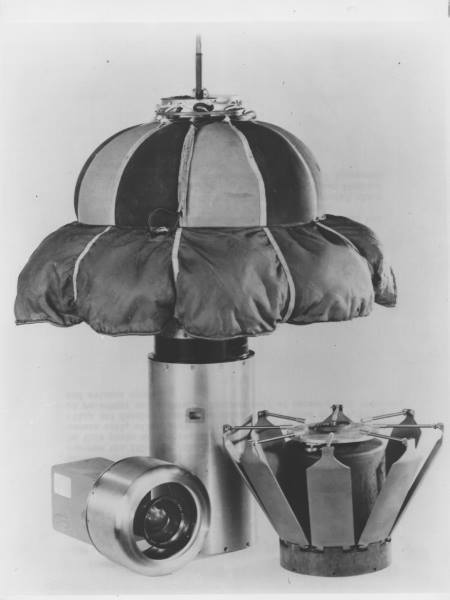Saturn V camera pods
Discussion
Copied from Facebook - thought some people here would be interested
"Footage seen from the Saturn rocket during staging was not a televised image, but from cameras that were mounted on the rocket. Each camera was inside a capsule that began operating three seconds before staging occurred and stopped 25 seconds after staging at which point it was jettisoned at around 200,000 feet and parachuted to the ocean. A balloon inflated to keep it afloat and radio beacon with high-intensity flashing light transmitted its location and a dye marker was released to assisted in recovery. It also had 85 grams of cupric acetate that was metered out into the water to repel sharks and sea life that could damage the balloon, capsule or recovery crew. The capsule was 7.7 inches in diameter, 28.5 inches long and weighed approximately 60 pounds. It was composed of 3 watertight compartments: a stainless steel nose section with quartz window to protect the camera from aerodynamic heating, an aluminum camera compartment and a recovery compartment with recovery aids & re-entry equipment. Some video had been transmitted during the early Saturn launches, but the quality was not the greatest. The U.S. Navy had success with the camera recovery method when they recovered film taken from spy satellites and the same method was incorporated with some of the Saturn rockets. Assigned recovery ships and aircraft would get deployed to the projected impact site to retrieve the camera capsules. The camera can be seen jettisoned at the end of filming when it is suddenly propelled forward before recording stops. The camera speed operated around four times faster than normal and made the footage taken appear to be in slow motion. Not every rocket had cameras installed and not all cameras were recovered. On SA-7, Hurricane Gladys dispersed the cameras in the recovery area that a search for them was called off. Two of the eight cameras on the Saturn 1 later washed ashore in the Bahamas, battered and covered in barnacles, but the film inside was undamaged."


"Footage seen from the Saturn rocket during staging was not a televised image, but from cameras that were mounted on the rocket. Each camera was inside a capsule that began operating three seconds before staging occurred and stopped 25 seconds after staging at which point it was jettisoned at around 200,000 feet and parachuted to the ocean. A balloon inflated to keep it afloat and radio beacon with high-intensity flashing light transmitted its location and a dye marker was released to assisted in recovery. It also had 85 grams of cupric acetate that was metered out into the water to repel sharks and sea life that could damage the balloon, capsule or recovery crew. The capsule was 7.7 inches in diameter, 28.5 inches long and weighed approximately 60 pounds. It was composed of 3 watertight compartments: a stainless steel nose section with quartz window to protect the camera from aerodynamic heating, an aluminum camera compartment and a recovery compartment with recovery aids & re-entry equipment. Some video had been transmitted during the early Saturn launches, but the quality was not the greatest. The U.S. Navy had success with the camera recovery method when they recovered film taken from spy satellites and the same method was incorporated with some of the Saturn rockets. Assigned recovery ships and aircraft would get deployed to the projected impact site to retrieve the camera capsules. The camera can be seen jettisoned at the end of filming when it is suddenly propelled forward before recording stops. The camera speed operated around four times faster than normal and made the footage taken appear to be in slow motion. Not every rocket had cameras installed and not all cameras were recovered. On SA-7, Hurricane Gladys dispersed the cameras in the recovery area that a search for them was called off. Two of the eight cameras on the Saturn 1 later washed ashore in the Bahamas, battered and covered in barnacles, but the film inside was undamaged."


Edited by MartG on Thursday 25th February 20:42
Interesting stuff.
There's a video here about the lunar lander's TV camera and how it took the pictures of man's first steps on the moon:
https://www.youtube.com/watch?v=OxoSnXZTtr4
She has a lot of other rocket-related stuff too.
There's a video here about the lunar lander's TV camera and how it took the pictures of man's first steps on the moon:
https://www.youtube.com/watch?v=OxoSnXZTtr4
She has a lot of other rocket-related stuff too.
Gassing Station | Science! | Top of Page | What's New | My Stuff




